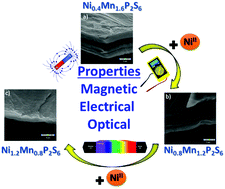Influence of the NiII/MnII ratio on the physical properties of heterometallic Ni2xMn(2−2x)P2S6 phases and potassium intercalates K0.8Ni2xMn(1.6−2x)P2S6·2H2O†‡
Abstract
Bimetallic Ni2xMn2−2xP2S6 phases, where 2X = 0.4 (Ni0.4), 0.8 (Ni0.8) and 1.2 (Ni1.2), were synthesized by a microwave assisted method, starting from the corresponding potassium intercalates K0.8Mn1.6P2S6·2H2O, K0.8Ni0.4Mn1.2P2S6·2H2O, and K0.8Ni0.8Mn0.8P2S6·2H2O. The magnetic, optical, and electrical properties were recorded, in order to visualize the influence of the secondary nickel(II) ions on the physical properties of the pristine Mn2P2S6 phase. Both dc susceptibility and EPR data show that the antiferromagnetic interactions are attenuated in the layers of the bimetallic phases, while the critical temperature remains constant (ca. 80 K) for all the bimetallic phases, similar to that of Mn2P2S6. Conversely, the absorption edge of the solid state UV-visible spectra shifted to lower energies as the percentage of nickel(II) increased, tending to that of the band gap value of the pristine Ni2P2S6 phase. Moreover, the electric conductivity of Ni0.4 was similar to that of the pristine Mn2P2S6 phase, while that of Ni0.8 and Ni1.2 approached the values of the electric conductivity of the pristine Ni2P2S6 phase. On the other hand, the potassium intercalates K0.8Mn1.6P2S6·2H2O and K0.8Ni0.4Mn1.2P2S6·2H2O showed magnetization at 16 K, the latter being much weaker as compared to the first. The detrimental effect of the secondary nickel(II) ions in the layers of the bimetallic phases became evident for K0.8Ni0.8Mn0.8P2S6·2H2O, where the magnetization at low temperatures was not observed. The absorption edge shifted to higher energy values for K0.8Mn1.6P2S6·2H2O and K0.8Ni0.4Mn1.2P2S6·2H2O, as compared to Mn2P2S6 and Ni0.4, respectively, but the value remained close to that of Ni2P2S6 for K0.8Ni0.8Mn0.8P2S6·2H2O. In Ni0.8 and Ni0.4, the electrical conductivity at low frequencies stems from polarization processes such as Maxwell/Wagner/Sillars electrode polarization. Moreover, an additional polarization process is observed in the intercalates because K+ ions in the interlayer act as charge transport carriers. Consequently, the interacalates present higher electrical conductivity compared with the pristine Mn2P2S6 phase, by a factor of ca. 102.



 Please wait while we load your content...
Please wait while we load your content...